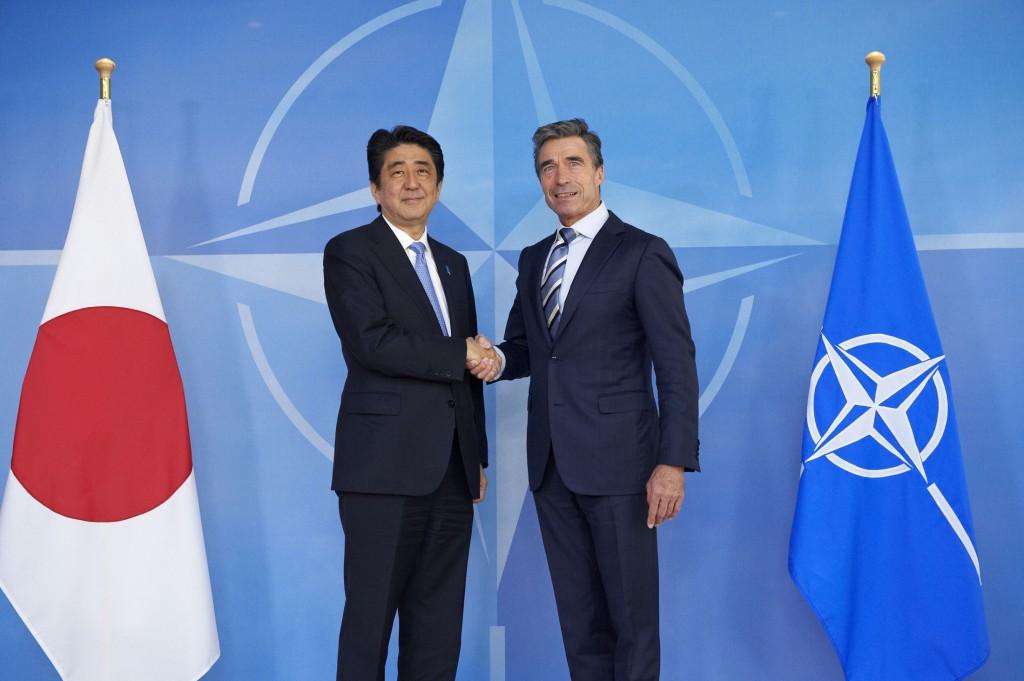Abe and a resurgent Japan
Posted By Rod Lyon on May 15, 2014 @ 14:35
 [1]Japanese Prime Minister Shinzo Abe has chalked up a string of wins lately—all in the field of strategic policy. The visit by President Obama led to a public strengthening of US commitments to defence of the Senkakus; last week’s new formal partnership agreement with NATO [2] underlined Tokyo’s continuing shift towards becoming a more ‘normal’ ally; and the latest moves to reinterpret the collective defence provisions permissible under Article 9 of the Constitution free the hands of Japanese policymakers to explore new forms of strategic engagement with friends and partners. All in all, it’s been a productive few weeks in Japanese strategic policy.
[1]Japanese Prime Minister Shinzo Abe has chalked up a string of wins lately—all in the field of strategic policy. The visit by President Obama led to a public strengthening of US commitments to defence of the Senkakus; last week’s new formal partnership agreement with NATO [2] underlined Tokyo’s continuing shift towards becoming a more ‘normal’ ally; and the latest moves to reinterpret the collective defence provisions permissible under Article 9 of the Constitution free the hands of Japanese policymakers to explore new forms of strategic engagement with friends and partners. All in all, it’s been a productive few weeks in Japanese strategic policy.
It’s true, of course, that Obama’s reassuring tones won’t completely assuage Tokyo’s concerns that its ally is playing a smaller role in Asia Pacific security these days. But the Japanese extracted from the president’s visit about as much as could have been reasonably expected. Obama’s reassurance that the Senkakus were covered by Article 5 of the Japan–US Security Treaty [3] wasn’t—as some have cast it—a promise to go to war with China. The Treaty is much like ANZUS: it commits the parties to act to meet the common danger if either is attacked, but it doesn’t say how they must act. Nor was Japan looking for such a promise; it wanted a US statement that distinguished between the Senkakus and the various South China Sea disputes, in which the US makes no determination of ownership. That was delivered—and the delivery should give Beijing pause for reflection.
The partnership agreement signed last week between Japan and NATO during Prime Minister Abe’s visit to Brussels can be seen in a variety of ways. The agreement is Japan’s Individual Partnership and Cooperation Program with NATO. Such agreements were established by the NATO Strategic Concept of 2010, and partners are allowed to tailor their program of cooperation to suit their interests. The formal agreement demonstrates that both partners see benefit in continuing to grow a relationship that dates back to the early 1990s, and already includes a range of practical cooperation in peacebuilding, crisis management, HADR, cyber defence, counterterrorism, nonproliferation, and participation in a range of military activities.
But there’s a new strategic-level motive for cooperation now: a shared determination to offset authoritarian great powers that are showing a new willingness to indulge in coercion and adventurism. Both Abe and NATO Secretary-General Anders Fogh Rasmussen made their positions plain at the joint press conference [4]. Rasmussen spoke of new concerns for European security: ‘Today we are facing the gravest crisis to European security since the end of the Cold War. This crisis has serious implications for the security and stability of the Euro-Atlantic area as a whole’. Where Rasmussen took a European crisis and went west, into the Atlantic, Abe took the same crisis and went east, into East Asia:
We will not tolerate any change of status quo through intimidation or coercion of force. … This is not only applicable to Europe or Ukraine. This is applicable to East Asia. And it is applicable to the whole world. This is something that the whole world has to consider.
Japan has long wanted NATO to play a larger role in the unfolding Asian security space, hoping the alliance might diplomatically ‘lean’ upon China from the west—much as Japan leaned on the Soviet Union from the east in the Cold War days. But that’s not something NATO’s going to be doing anytime soon. The alliance is still struggling to find a good response to Russian adventurism in relation to Ukraine.
Finally, the issue of collective self-defence has moved another step forward through the maze of Japan’s political system. The Advisory Panel on Reconstruction of the Legal Basis for Security, first established by Abe in April 2007 is due to submit its second report to the Prime Minister today. The report will urge a reinterpretation of Article 9 of the Japanese Constitution to allow for collective self-defence in certain circumstances.
The right to collective defence is shrouded with a set of conditions [5] designed to ensure that the step is seen as an evolutionary rather than a revolutionary change. And Abe is still working to build the level of domestic political consensus [6] that would allow the change to be effective. But coming on top of a range of earlier Abe-driven changes—including the establishment of the National Security Council, and the adoption of a National Security Strategy [7] (PDF), new National Defence Program Guidelines [8] (PDF), and the Three Principles of the Transfer of Defence Equipment and Technology [9] (PDF)—the reinterpretation of Article 9 is another sign that Abe’s campaign to make Japan a ‘normal’ player in the Asia-Pacific is progressing well.
Rod Lyon is a fellow at ASPI and executive editor of The Strategist. Image courtesy of NATO [10].
Article printed from The Strategist: https://aspistrategist.ru
URL to article: /abe-and-a-resurgent-japan/
URLs in this post:
[1] Image: https://aspistrategist.ru/wp-content/uploads/2014/05/Abe-NATO.jpg
[2] new formal partnership agreement with NATO: http://www.nato.int/cps/en/natolive/news_109508.htm
[3] Japan–US Security Treaty: http://www.mofa.go.jp/region/n-america/us/q&a/ref/1.html
[4] the joint press conference: http://www.nato.int/cps/en/natolive/opinions_109507.htm?selectedLocale=en
[5] a set of conditions: http://www.defensenews.com/article/20140511/DEFREG03/305110018/Japan-Take-Major-Step-Toward-Collective-Self-Defense
[6] political consensus: http://www.japantimes.co.jp/news/2014/05/14/national/politics-diplomacy/ldp-woo-partner-self-defense/#.U3P3b9KSzh4
[7] National Security Strategy: http://japan.kantei.go.jp/96_abe/documents/2013/__icsFiles/afieldfile/2013/12/17/NSS.pdf
[8] National Defence Program Guidelines: http://japan.kantei.go.jp/96_abe/documents/2013/__icsFiles/afieldfile/2013/12/17/NDPG(Summary).pdf
[9] Three Principles of the Transfer of Defence Equipment and Technology: http://www.mofa.go.jp/files/000034953.pdf
[10] NATO: http://www.nato.int/cps/en/natolive/photos_109504.htm
Click here to print.